Experimental Study on Enhanced Oil Recovery of Adaptive System after Polymer Flooding
Abstract
:1. Introduction
2. Materials and Methods
2.1. Experimental Materials
2.2. System Static Performance Evaluation Experiment
2.3. Flow Experiment
2.4. Experiment on the Microscopic Transport Behavior of the System
2.5. Profile Control Evaluation Experiment
2.6. Experiment on the Oil Displacement Effect Evaluation of the Adaptive System
3. Results and Discussion
3.1. Static Performance Analysis of the System
3.2. Evaluation of the Seepage Capacity
3.3. Microscopic Migration Behavior
3.4. Profile Control Capability Analysis
3.5. Displacement Experiment of the Four-Layer Heterogeneous Well Pattern Model
3.5.1. Determination of the Resistance–Oil Saturation Standard Relation Curve
3.5.2. Oil Displacement Effect Evaluation and Analysis of the Adaptive System of the Two-Injection and Two-Production Pattern after Polymer Flooding
- (1)
- Dynamic production curve
- (2)
- The planar saturation field in the adaptive flooding stage
4. Conclusions
- (1)
- Preformed particle gel (PPG) notably enhances the viscoelasticity within the ASP-PPG system, exhibiting a superior elastic modulus (G′) and viscous modulus (G′) compared to the standalone ASP system. The adaptive system also has strong stability, with the viscosity retention exceeding 90% over a long period. Notably, the oil–water interface tension remains consistently at an ultra-low magnitude (10−3 mN/m).
- (2)
- The adaptive system exhibits remarkable mobility and can be smoothly delivered deep into the core. The adaptive system’s blocking effect on the core increases the resistance of the seepage, contributing to a large resistance coefficient and residual resistance coefficient.
- (3)
- Preformed particle gel (PPG) can access previously inaccessible oil areas while exhibiting elastic deformation features during oil displacement. The primary mode of PPG transport within the pore throat involves elastic deformation or partition—transport—elastic deformation or partition—deep transport.
- (4)
- The adaptive system can effectively improve the liquid absorption profile of heterogeneous reservoirs after polymer flooding. Notably, the profile improvement effect becomes more pronounced with diminishing permeability differences. For instance, in cases of a permeability level difference of 3.6, the dispersion rate in the high permeability layer decreases from 84% to 38%, and the dispersion rate in the low permeability layer increases from 16% to 62%, leading to an overall profile improvement rate of 88.33%.
- (5)
- The incremental recovery of the adaptive flooding stage after polymer flooding is 18.4%. The oil saturation within the ultra-high, high, medium, and low permeability layers declines 5.09%, 7.01%, 13.81%, and 15.45%, respectively. The adaptive system can effectively access the remaining oil in the medium and low permeability layers, significantly enhancing the recovery factor in these regions.
Author Contributions
Funding
Institutional Review Board Statement
Informed Consent Statement
Data Availability Statement
Acknowledgments
Conflicts of Interest
References
- Gbadamosi, A.; Patil, S.; Kamal, M.S.; Adewunmi, A.A.; Yusuff, A.S.; Agi, A.; Oseh, J. Application of Polymers for Chemical Enhanced Oil Recovery: A Review. Polymers 2022, 14, 1433. [Google Scholar] [CrossRef]
- An, Y.; Yao, X.; Zhong, J.; Pang, S.; Xie, H. Enhancement of oil recovery by surfactant-polymer synergy flooding: A review. Polym. Polym. Compos. 2022, 30. [Google Scholar] [CrossRef]
- Pogaku, R.; Fuat, N.H.M.; Sakar, S.; Cha, Z.W.; Musa, N.; Tajudin, D.N.A.A.; Morris, L.O. Polymer flooding and its combinations with other chemical injection methods in enhanced oil recovery. Polym. Bull. 2018, 75, 1753–1774. [Google Scholar] [CrossRef]
- Gao, Q.; Zhong, C.; Han, P.; Cao, R. Characteristics of Preferential Flow Paths in Reservoirs After Polymer Flooding and an Adaptive Compound Flooding Method. Chem. Technol. Fuels Oils 2021, 57, 368–375. [Google Scholar] [CrossRef]
- Pi, Y.; Su, Z.; Cao, R.; Li, B.; Liu, J.; Fan, X.; Zhao, M. Experimental Study on Enhanced Oil Recovery of PPG/ASP Heterogeneous System after Polymer Flooding. Gels 2023, 9, 427. [Google Scholar] [CrossRef] [PubMed]
- Xu, T.; Li, X.; Zhang, X.; Zhao, F. Parallel-column experiments for enhancing oil recovery after polymer flooding. Pet. Explor. Dev. 2004, 31, 98–100. [Google Scholar]
- Nie, X.; Chen, J.; Cao, Y.; Zhang, J.; Zhao, W.; He, Y.; Hou, Y.; Yuan, S. Investigation on Plugging and Profile Control of Polymer Microspheres as a Displacement Fluid in Enhanced Oil Recovery. Polymers 2019, 11, 1993. [Google Scholar] [CrossRef]
- Yin, D.; Zhao, D.; Gao, J.; Gai, J. Experimental Study of Enhancing Oil Recovery with Weak Base Alkaline/Surfactant/Polymer. Int. J. Polym. Sci. 2017, 2017, 4652181. [Google Scholar] [CrossRef]
- Yangwen, Z.H.U. A laboratory study of enhancing oil recovery with petroleum sulfonant system after polymer flooding. Pet. Explor. Dev. 2007, 34, 212–215. [Google Scholar]
- Yernazarova, A.; Kayirmanova, G.; Baubekova, A.; Zhubanova, A. Microbial Enhanced Oil Recovery. In Chemical Enhanced Oil Recovery; IntechOpen: London, UK, 2016; pp. 147–167. [Google Scholar]
- Wu, F.; Hou, J.; Wang, Z.; Ma, Y.; Wang, D. An enhanced oil recovery technique by targeted delivery ASP flooding. Pet. Explor. Dev. 2018, 45, 321–327. [Google Scholar] [CrossRef]
- Khan, M.Y.; Samanta, A.; Ojha, K.; Mandal, A. Design of Alkaline/Surfactant/Polymer (ASP) Slug and its use in Enhanced Oil Recovery. Pet. Sci. Technol. 2009, 27, 1926–1942. [Google Scholar] [CrossRef]
- Liu, W.; Luo, L.; Liao, G.; Zuo, L.; Wei, Y.; Jiang, W. Experimental study on the mechanism of enhancing oil recovery by polymer-surfactant binary flooding. Pet. Explor. Dev. 2017, 44, 636–643. [Google Scholar] [CrossRef]
- Cheraghian, G. Effect of nano titanium dioxide on heavy oil recovery during polymer flooding. Pet. Sci. Technol. 2016, 34, 633–641. [Google Scholar] [CrossRef]
- Sun, L.; Wu, X.; Zhou, W.; Li, X.; Han, P. Technologies of enhancing oil recovery by chemical flooding in Daqing Oilfield, NE China. Pet. Explor. Dev. 2018, 45, 673–684. [Google Scholar] [CrossRef]
- Fu, H.; Bai, Z.; Guo, H.; Yang, K.; Guo, C.; Liu, M.; Liang, L.; Song, K. Remaining Oil Distribution Law and Development Potential Analysis after Polymer Flooding Based on Reservoir Architecture in Daqing Oilfield, China. Polymers 2023, 15, 2137. [Google Scholar] [CrossRef] [PubMed]
- Bai, B.; Liu, W.; Li, L.; Liu, G.; Tang, X. An analysis on intrinsic factors influencing the properties of pre-crosslinking gelled particles. Pet. Explor. Dev. 2002, 29, 103–105. [Google Scholar]
- Lenji, M.A.; Haghshenasfard, M.; Sefti, M.V.; Salehi, M.B.; Heidari, A. Experimental study of swelling and rheological behavior of preformed particle gel used in water shutoff treatment. J. Pet. Sci. Eng. 2018, 169, 739–747. [Google Scholar] [CrossRef]
- Lai, N.; Chen, S.; Tang, L.; Huang, Y.; Xu, H. Migration characteristics and profile control capabilities of preformed particle gel in porous media. Petroleum 2022, 8, 483–498. [Google Scholar] [CrossRef]
- Wang, L.; Xia, H.; Han, P.; Cao, R.; Xu, T.; Li, W.; Zhang, H.; Zhang, S. Synthesis of new PPG and study of heterogeneous combination flooding systems. J. Dispers. Sci. Technol. 2022, 43, 164–177. [Google Scholar] [CrossRef]
- Alhuraishawy, A.K.; Sun, X.; Bai, B.; Wei, M.; Imqam, A. Areal sweep efficiency improvement by integrating preformed particle gel and low salinity water flooding in fractured reservoirs. Fuel 2018, 221, 380–392. [Google Scholar] [CrossRef]
- Sang, Q.; Li, Y.; Yu, L.; Li, Z.; Dong, M. Enhanced oil recovery by branched-preformed particle gel injection in parallel-sandpack models. Fuel 2014, 136, 295–306. [Google Scholar] [CrossRef]
- Gao, Q.; Zhong, C.; Han, P.; Cao, R.; Jiang, G. Synergistic Effect of Alkali-Surfactant-Polymer and Preformed Particle Gel on Profile Control after Polymer Flooding in Heterogeneous Reservoirs. Energy Fuels 2020, 34, 15957–15968. [Google Scholar] [CrossRef]
- Gong, H.; Zhang, H.; Xu, L.; Li, K.; Yu, L.; San, Q.; Li, Y.; Dong, M. The Synergistic Effect of Branched-Preformed Particle Gel and Hydrolyzed Polyacrylamide on Further-Enhanced Oil Recovery after Polymer Flooding. Energy Fuels 2017, 31, 7904–7910. [Google Scholar] [CrossRef]
- Wu, D.; Zhou, K.; Zhao, F.; Lu, X.; An, Z.; Liu, S.; Hou, J. Determination of Permeability Contrast Limits for Applying Polymer Solutions and Viscoelastic Particle Suspensions in Heterogeneous Reservoirs. Energy Fuels 2022, 36, 7495–7506. [Google Scholar] [CrossRef]
- Bai, B.; Liu, Y.; Coste, J.P.; Li, L. Preformed particle gel for conformance control: Transport mechanism through porous media. Spe Reserv. Eval. Eng. 2007, 10, 176–184. [Google Scholar] [CrossRef]
- Zhao, G.; Dai, C.; Zhao, M. Investigation of the Profile Control Mechanisms of Dispersed Particle Gel. PLoS ONE 2014, 9, e100471. [Google Scholar] [CrossRef]
- Sun, J.; Feng, P.; Chi, P.; Yan, W. Microscopic Conductivity Mechanism and Saturation Evaluation of Tight Sandstone Reservoirs: A Case Study from Bonan Oilfield, China. Energies 2022, 15, 1368. [Google Scholar] [CrossRef]
- Archie, G.E. The electrical resistivity log as an aid in determining some reservoir characteristics. Trans. Am. Inst. Min. Metall. Eng. 1942, 146, 54–61. [Google Scholar] [CrossRef]
- Pi, Y.; Liu, J.; Cao, R.; Liu, L.; Ma, Y.; Gu, X.; Li, X.; Fan, X.; Zhao, M. Visualized Study on a New Preformed Particle Gels (PPG) plus Polymer System to Enhance Oil Recovery by Oil Saturation Monitoring Online Flooding Experiment. Gels 2023, 9, 81. [Google Scholar] [CrossRef] [PubMed]



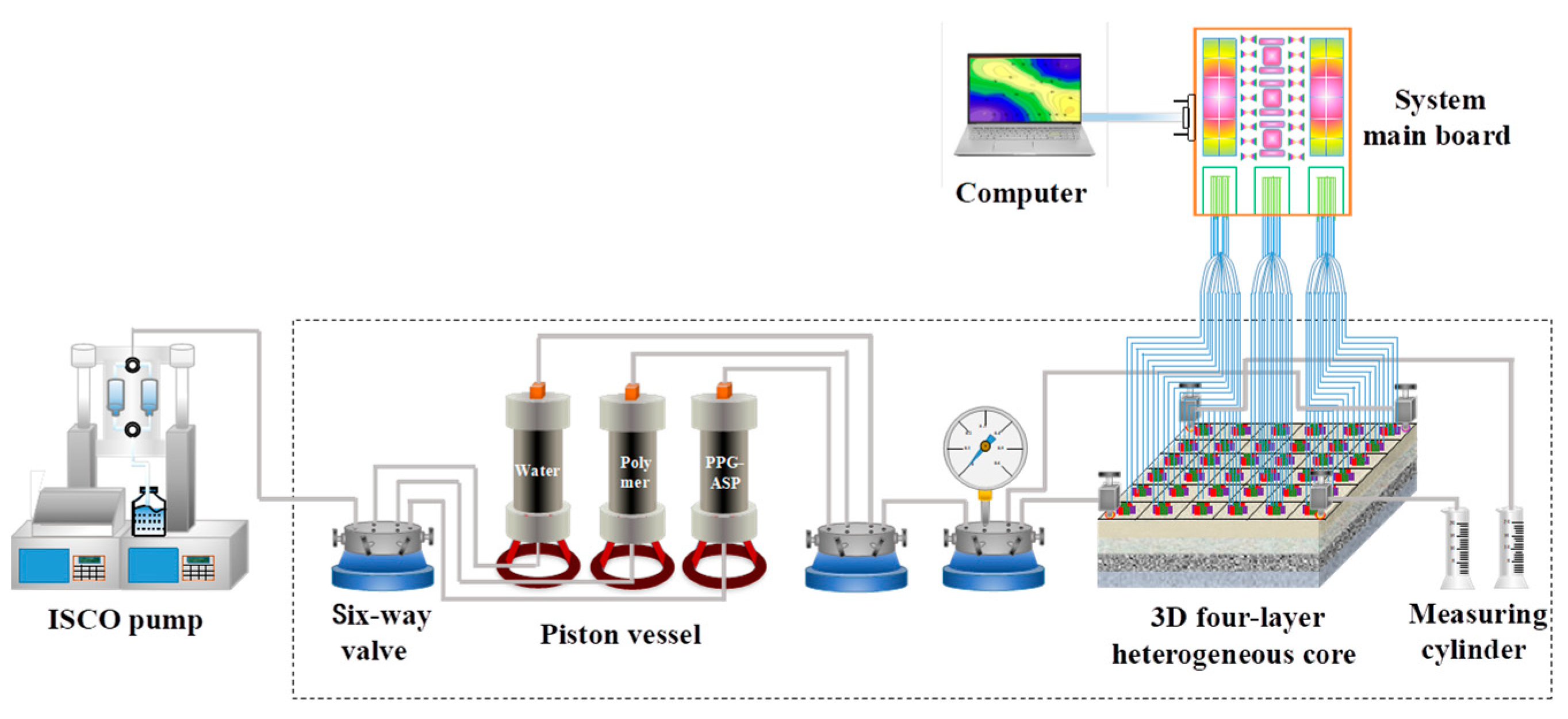
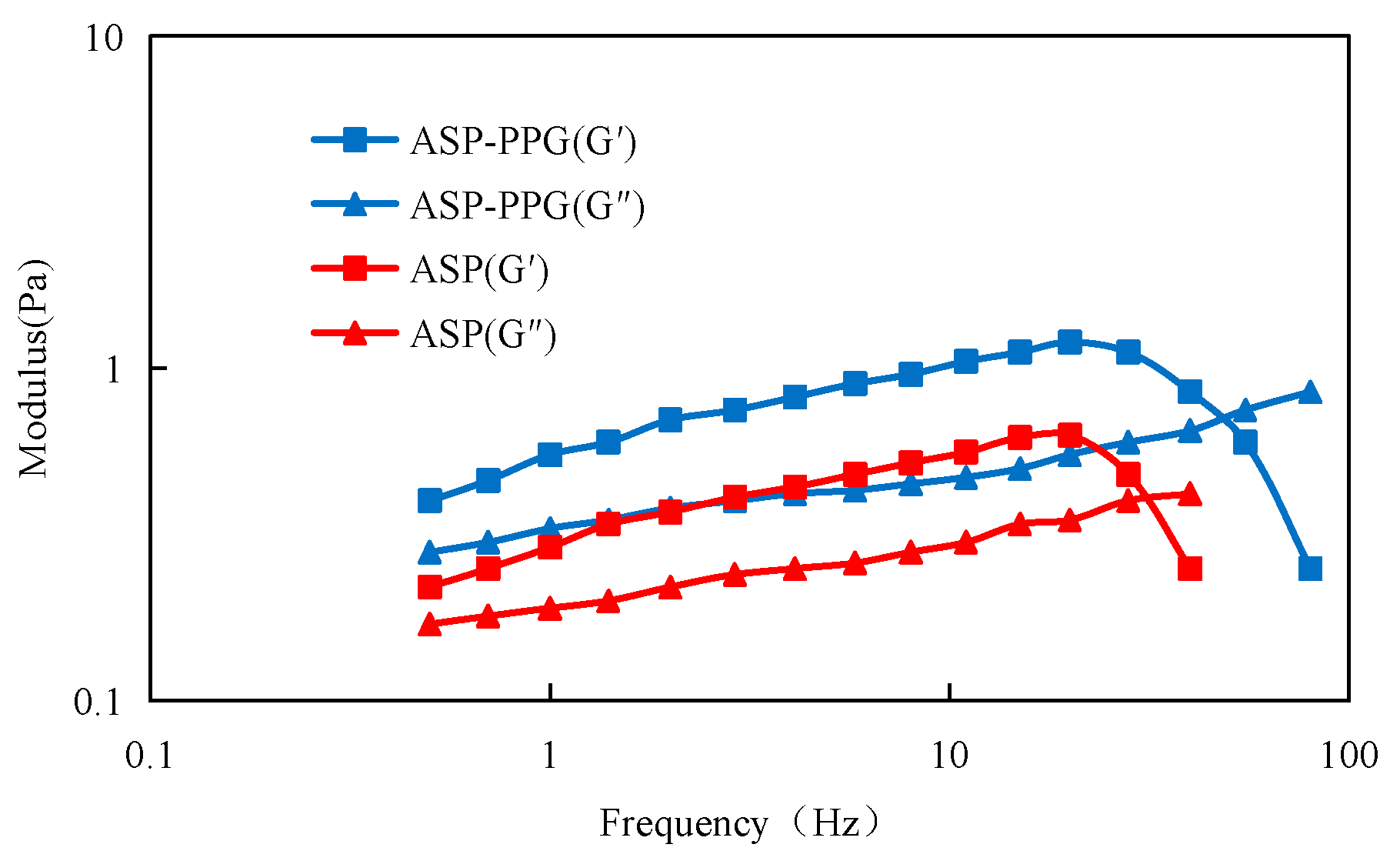
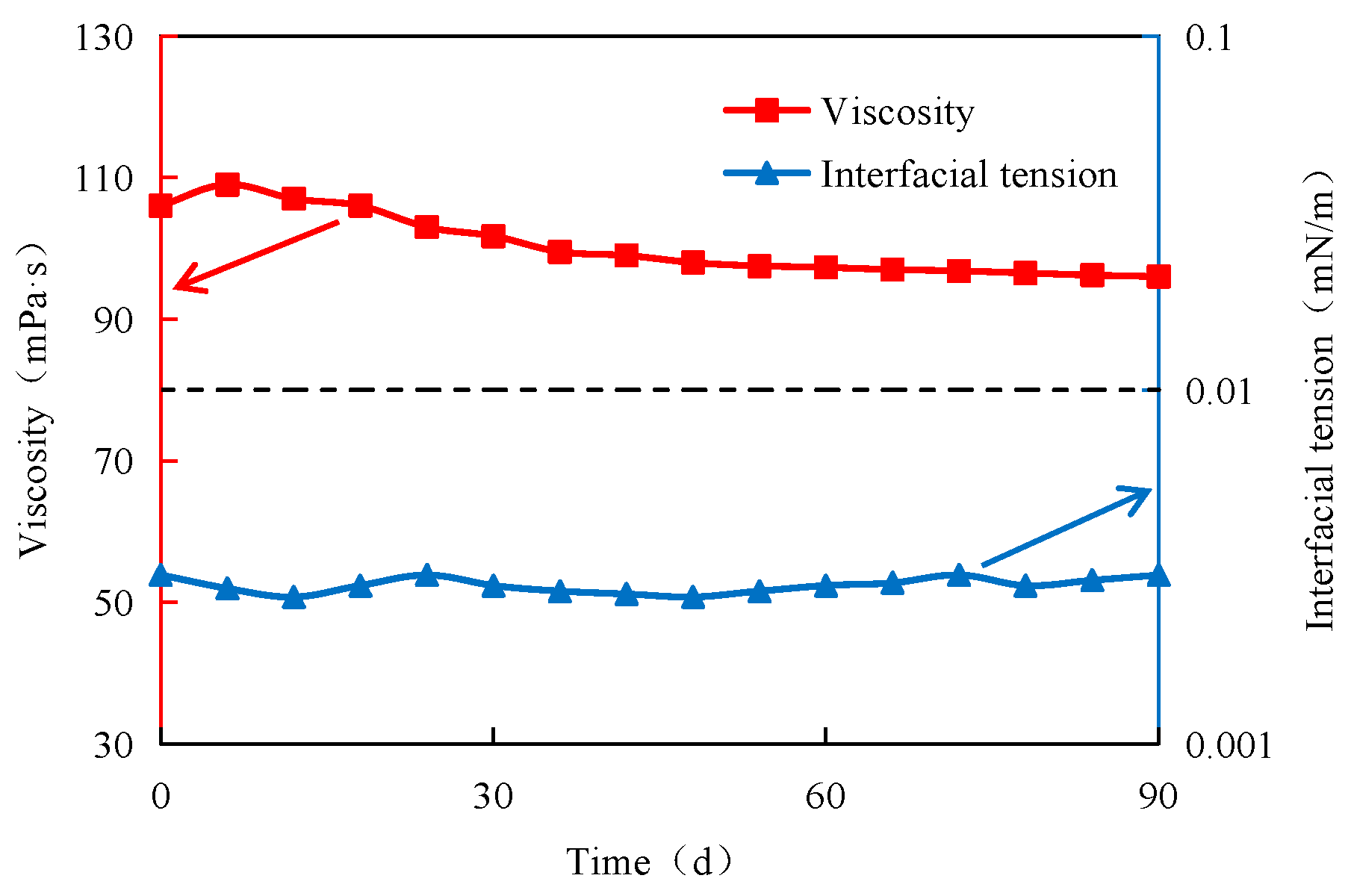


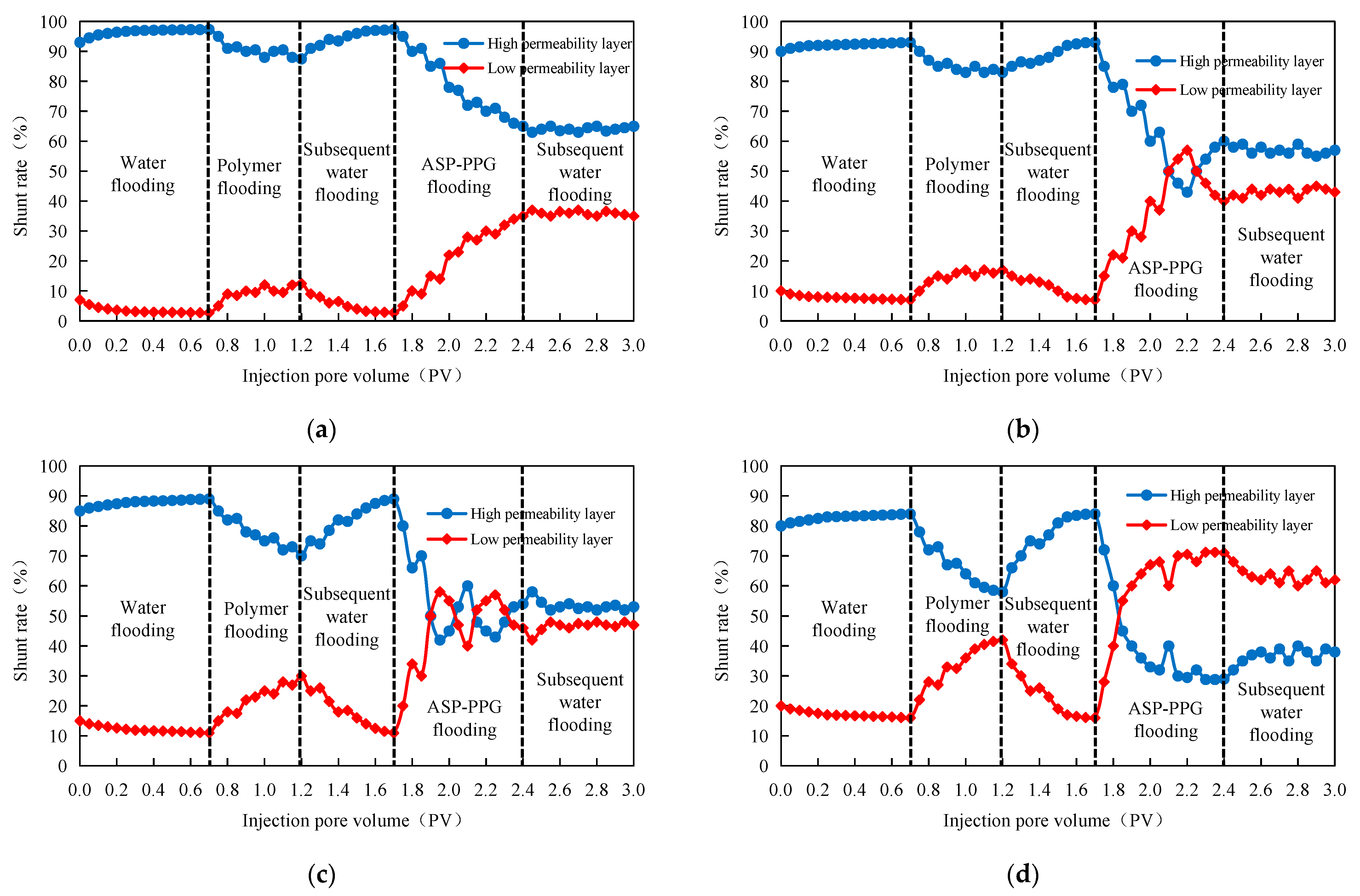



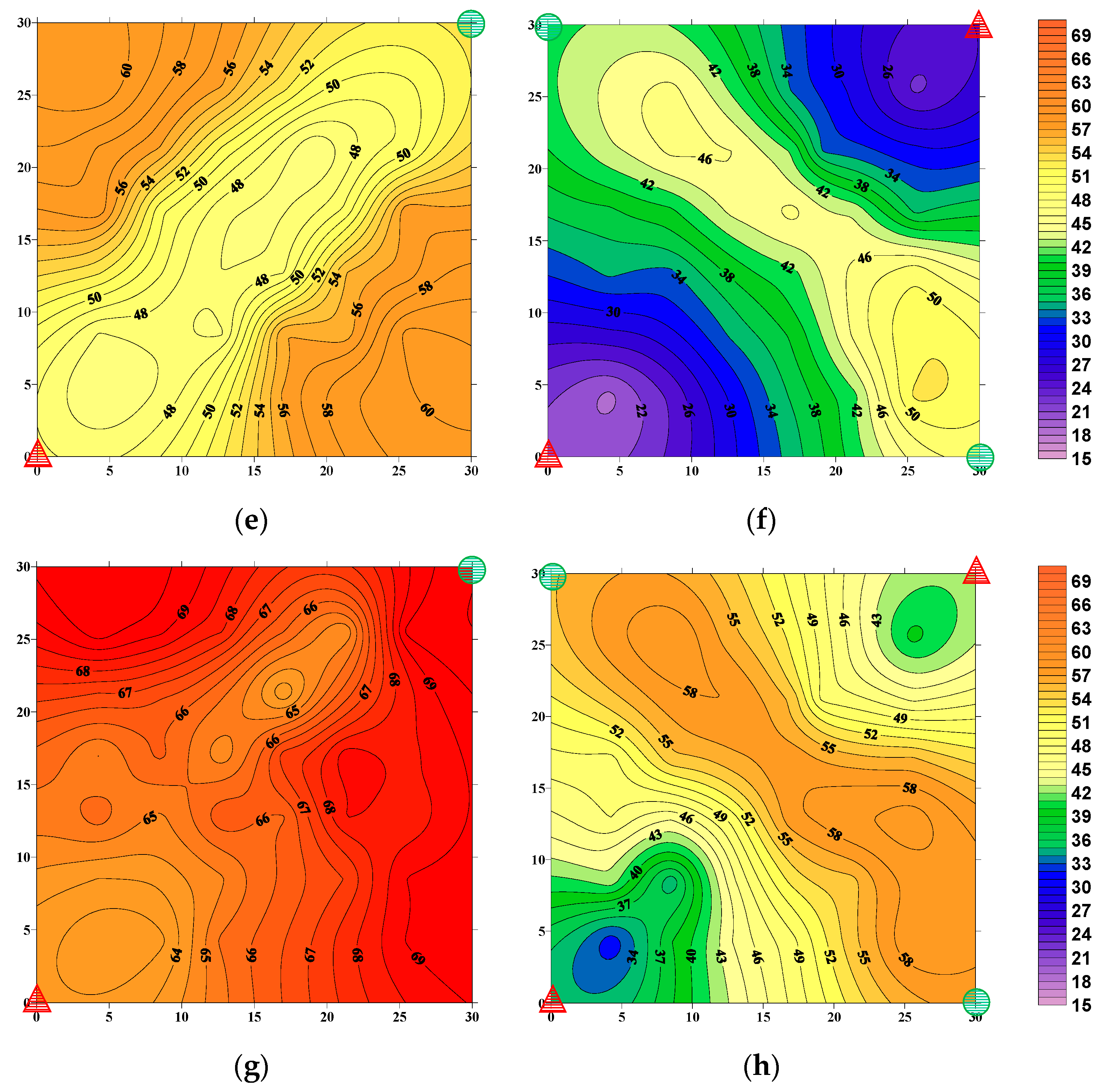
| NaHCO3 | NaCl | KCl | MgSO4 | Na2SO4 | CaCl2 | |
|---|---|---|---|---|---|---|
| Concentration (g/L) | 2.829 | 3.489 | 0.02 | 0.262 | 0.114 | 0.064 |
| No. | Simulated Layer | Permeability (×10−3 μm2) | Dimensions of Core (mm) | Porosity (%) |
|---|---|---|---|---|
| 1 | High permeability layer | 1800 | 1000 × 45 × 45 | 27.02 |
| 2 | Low permeability layer | 3000 | 28.89 |
| No. | Permeability (×10−3 μm2) | Dimensions of Core (mm) | Porosity (%) | Permeability Difference |
|---|---|---|---|---|
| 1 | 200 | 300 × 45 × 22.5 | 22.68 | 15 |
| 3000 | 28.72 | |||
| 2 | 200 | 300 × 45 × 22.5 | 22.67 | 9 |
| 1800 | 26.13 | |||
| 3 | 500 | 300 × 45 × 22.5 | 23.23 | 6 |
| 3000 | 28.71 | |||
| 4 | 500 | 300 × 45 × 22.5 | 23.22 | 3.6 |
| 1800 | 26.12 |
| Layers | Permeability (×10−3 μm2) | Dimensions of Core (mm) | Porosity (%) | Mean Porosity (%) |
|---|---|---|---|---|
| Low permeability layer | 200 | 300 × 300 × 15 | 22.58 | 25.17 |
| Intermediate permeability layer | 500 | 23.21 | ||
| High permeability layer | 1800 | 26.11 | ||
| Ultra-hypertonic layer | 3000 | 28.79 |
| Permeability (×10−3 μm2) | Pressure Measuring Point | Water Flooding Stage (MPa) | ASP-PPG System (MPa) | Subsequent Water Flooding (MPa) | Drag Coefficient | Residual Drag Coefficient |
|---|---|---|---|---|---|---|
| 1800 | Pressure 0 | 0.006 | 0.85 | 0.31 | 141.7 | 51.7 |
| Pressure 1 | 0.006 | 0.61 | 0.24 | 101.7 | 40.0 | |
| Pressure 2 | 0.006 | 0.41 | 0.19 | 68.3 | 31.7 | |
| Pressure 3 | 0.006 | 0.29 | 0.16 | 48.3 | 26.7 | |
| Pressure 4 | 0.006 | 0.18 | 0.12 | 30.0 | 20.0 | |
| 3000 | Pressure 0 | 0.004 | 0.52 | 0.16 | 130.0 | 40.0 |
| Pressure 1 | 0.004 | 0.34 | 0.12 | 85.0 | 30.0 | |
| Pressure 2 | 0.004 | 0.26 | 0.09 | 65.0 | 22.5 | |
| Pressure 3 | 0.004 | 0.18 | 0.07 | 45.0 | 17.5 | |
| Pressure 4 | 0.004 | 0.11 | 0.05 | 27.5 | 12.5 |
| No. | Permeability (×10−3 μm2) | Permeability Level Difference | Relative Suction Ratio (%) | Profile Improvement Rate (%) | |
|---|---|---|---|---|---|
| Before Treatment | After Treatment | ||||
| 1 | 3000 | 15 | 97.3 | 65 | 94.85 |
| 200 | 2.7 | 35 | |||
| 2 | 1800 | 9 | 93 | 57 | 90.02 |
| 200 | 7 | 43 | |||
| 3 | 3000 | 6 | 89 | 53 | 86.06 |
| 500 | 11 | 47 | |||
| 4 | 1800 | 3.6 | 84 | 38 | 88.33 |
| 500 | 16 | 62 | |||
| Recovery Factor in Water Flooding Stage (%) | Recovery Factor in Polymer Flooding Stage (%) | Recovery Factor in Adaptive Flooding Stage (%) | Total Recovery Rate (%) |
|---|---|---|---|
| 32.4 | 15.6 | 18.4 | 66.4 |
Disclaimer/Publisher’s Note: The statements, opinions and data contained in all publications are solely those of the individual author(s) and contributor(s) and not of MDPI and/or the editor(s). MDPI and/or the editor(s) disclaim responsibility for any injury to people or property resulting from any ideas, methods, instructions or products referred to in the content. |
© 2023 by the authors. Licensee MDPI, Basel, Switzerland. This article is an open access article distributed under the terms and conditions of the Creative Commons Attribution (CC BY) license (https://creativecommons.org/licenses/by/4.0/).
Share and Cite
Pi, Y.; Fan, X.; Liu, L.; Zhao, M.; Jiang, L.; Cheng, G. Experimental Study on Enhanced Oil Recovery of Adaptive System after Polymer Flooding. Polymers 2023, 15, 3523. https://doi.org/10.3390/polym15173523
Pi Y, Fan X, Liu L, Zhao M, Jiang L, Cheng G. Experimental Study on Enhanced Oil Recovery of Adaptive System after Polymer Flooding. Polymers. 2023; 15(17):3523. https://doi.org/10.3390/polym15173523
Chicago/Turabian StylePi, Yanfu, Xinyu Fan, Li Liu, Mingjia Zhao, Linxiao Jiang, and Guoyu Cheng. 2023. "Experimental Study on Enhanced Oil Recovery of Adaptive System after Polymer Flooding" Polymers 15, no. 17: 3523. https://doi.org/10.3390/polym15173523
APA StylePi, Y., Fan, X., Liu, L., Zhao, M., Jiang, L., & Cheng, G. (2023). Experimental Study on Enhanced Oil Recovery of Adaptive System after Polymer Flooding. Polymers, 15(17), 3523. https://doi.org/10.3390/polym15173523






